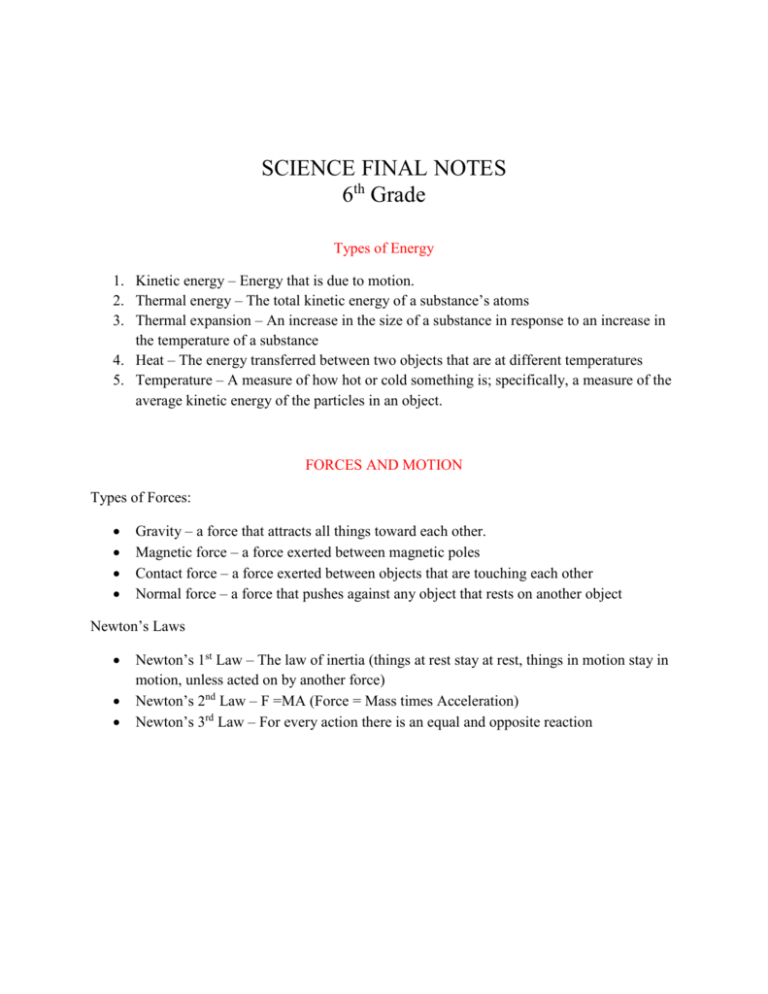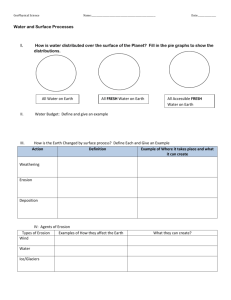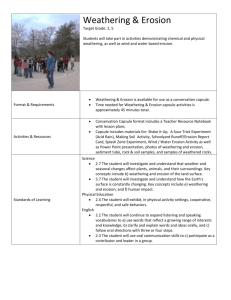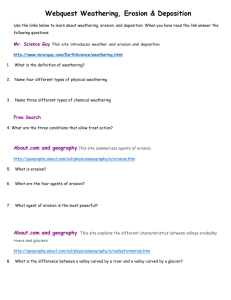SCIENCE FINAL NOTES 6th Grade Types of Energy Kinetic energy
advertisement

SCIENCE FINAL NOTES 6th Grade Types of Energy 1. Kinetic energy – Energy that is due to motion. 2. Thermal energy – The total kinetic energy of a substance’s atoms 3. Thermal expansion – An increase in the size of a substance in response to an increase in the temperature of a substance 4. Heat – The energy transferred between two objects that are at different temperatures 5. Temperature – A measure of how hot or cold something is; specifically, a measure of the average kinetic energy of the particles in an object. FORCES AND MOTION Types of Forces: Gravity – a force that attracts all things toward each other. Magnetic force – a force exerted between magnetic poles Contact force – a force exerted between objects that are touching each other Normal force – a force that pushes against any object that rests on another object Newton’s Laws Newton’s 1st Law – The law of inertia (things at rest stay at rest, things in motion stay in motion, unless acted on by another force) Newton’s 2nd Law – F =MA (Force = Mass times Acceleration) Newton’s 3rd Law – For every action there is an equal and opposite reaction LIFE SCIENCE VOCABULARY Cell – In biology, the smallest unit that can perform all life processes; cells are covered by a membrane and contain DNA and cytoplasm. Cell membrane – A phospholipid layer that covers a cell’s surface and acts as a barrier between the inside of a cell and the cell’s environment. CELL THEORY: All organisms are made up of one or more cells. Cells are the basic unit of life. All cells come from existing cells. ALL cells have a cell membrane, cytoplasm, organelles, and DNA. WEATHERING & EROSION VOCABULARY 1. Floodplain – an area along a river that forms from sediments deposited when a river overflows its banks 2. Delta – a fan shaped mass of material deposited at the mouth of a stream 3. Alluvial fan – a fan shaped mass of material deposited by a stream when the slope of the land decreases sharply 4. Dune – a mound of wind-deposited sand that moves as a result of the action of wind 5. Loess – fine-grained sediments of quartz, feldspar, hornblende, mica, and clay deposited by the wind WEATHERING AND EROSION NOTES - Weathering – the breaking down of rock. Weathering occurs until all that is left is soil. Two types of weathering – chemical and physical weathering. o Chemical weathering – changes the chemical composition of the rocks due to chemicals in the atmosphere, like chemicals in rain causing rust. o Physical weathering – weathering due to something in the environment like heat, water, or pressure, like water in the cracks of rocks that freezes and makes the cracks bigger - - - Erosion - the process by which soil and rock are removed from the Earth's surface by wind or water and then transported to other locations. Erosion is typically a natural process but it is often also caused by humans. Erosion can be cause by: o Gravity – movement down a slope due to force of gravity o Water – caused by rain, a river o Shoreline – erosion due to the action of currents and waves o Wind – movement of material by wind Weathering and erosion are part of a cycle of a breaking down and moving of material. o First, weathering slowly breaks down material o Then erosion carries that material to a new location and deposits it Wind in the Atmosphere 1. Wind – The movement of air caused by differences in air pressure. 2. Coriolis Effect – The curving of the path of a moving object from an otherwise straight path due to Earth’s rotation. 3. Global wind – The movement of air over Earth’s surface in patterns that are worldwide. See image below: 4. Local wind – The movement of air over short distances; occurs in specific areas as a result of certain geographical features. 5. Jet stream – A band of strong winds that blow in the upper troposphere.







